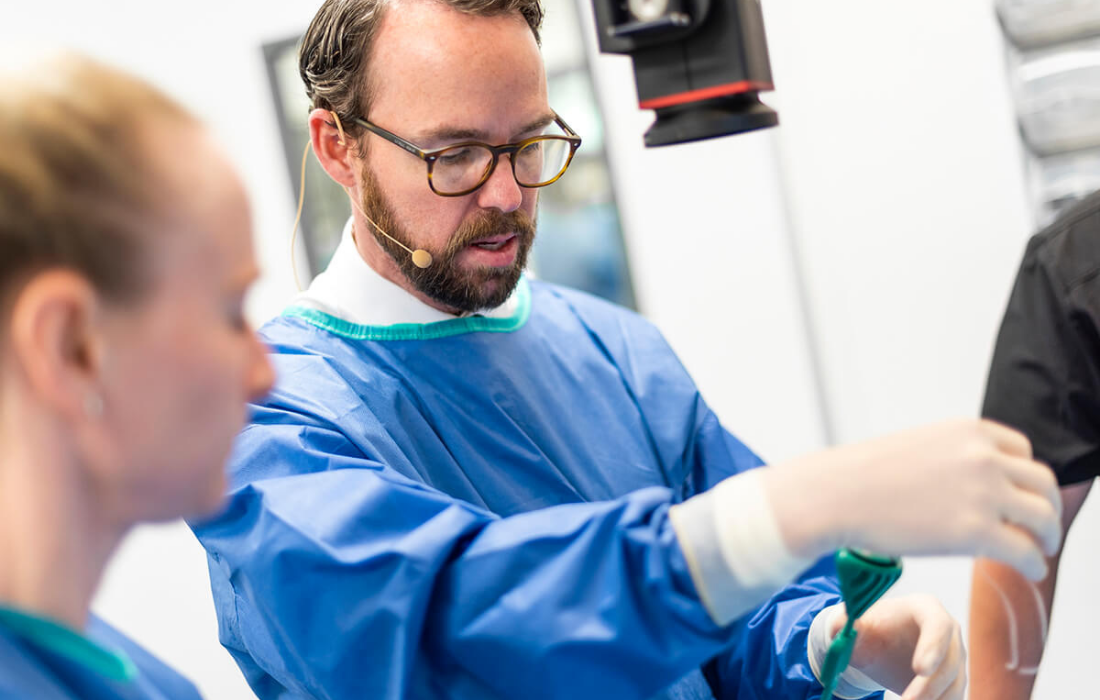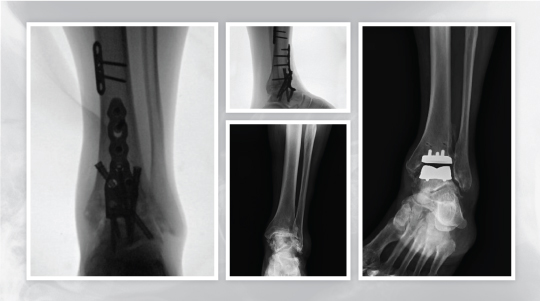What Is Total Ankle Replacement?
Total ankle replacement (also called total ankle arthroplasty, or TAA) is a surgical option for patients with arthritis of the ankle. This involves resurfacing the end of the tibia (shin bone) and the talus (lower bone of the ankle) with metal components and placing a plastic piece in between them.
This operation can relieve pain and maintain motion in the arthritic ankle joint and is an alternative to arthrodesis (ankle fusion), which can relieve pain but eliminates motion in the joint. Another benefit of maintaining ankle range of motion is that the surrounding joints in the foot do not take on any additional stress and create accelerated degeneration. Although it does not have the same long-term track record of hip or knee replacement, shorter-term studies on ankle replacement look very promising.
Why Does My Ankle Hurt?
Ankle arthritis is degeneration of the cartilage. It creates a painful, stiff joint that can affect your quality of life.
The bones of your ankle are covered by a smooth and resilient substance known as cartilage. It is cartilage that allows the ankle joint to move smoothly and painlessly. Osteoarthritis is a disease process in which the cartilage becomes thinner and rougher. When this occurs, joint motion becomes stiff and painful.
The ankle is the most commonly injured joint in the body and bears the most weight per square centimeter. The cartilage is very thin in the ankle compared to the hip and knee.
The ankle bears five to seven times of your body weight during walking. Arthritis in the knee and hip often results from normal “wear and tear” of the joint due to aging, but ankle arthritis most commonly occurs after trauma to the ankle. This trauma may be caused by:
- Ankle fracture
- Ankle instability
- Ankle sprains
- Malalignment of the foot or leg
Am I a Candidate for TAA?
If you have painful arthritis and nonsurgical treatment has failed, you may want to talk to your doctor about TAA. You are a good candidate for ankle replacement if you have maintained ankle range of motion and have minimal to no ankle deformity.
Typically, older patients who place less demand and impact on the ankle joint are great candidates; however, younger patients (usually in their 50s) are beginning to have replacements as well.
Who Should NOT Have an Ankle Replacement?
An ankle replacement is not the best option for every patient with ankle arthritis. Ankles that are severely deformed or unstable or have had an infection in the past may be better treated with fusion. Similarly, patients with serious medical problems such as diabetes, obesity or problems with blood supply are generally not good candidates for ankle replacement.
TAA is not recommended if you have:
- An active or prior deep infection in the ankle joint
- Inadequate bone to support the implants
- Neuromuscular disease that impairs muscles, resulting in poor muscle tone and function in the ankle
- Charcot neuropathy (loss of sensation in foot and ankle)
- Severe ankle deformity
- Poor musculature quality at the surgical site
How Is the Surgery Performed?
Ankle replacement surgery is performed using general anesthesia with a nerve block around the knee for postoperative pain control. The doctor places a tourniquet around the thigh to help control bleeding and improve visualization during surgery.
The surgeon makes an incision in the front or side of the ankle depending on the type of implant used. Guides are then placed on the bones, and their positions are viewed with an X-ray to determine accurate location before any cuts are made. The surgeon cuts the bones, which allows for the placement of metal and plastic components to recreate the ankle joint.
Some patients have tight calf muscles or Achilles tendon (which connects the calf muscle to the heel bone) that needs to be lengthened to help increase the range of motion at the ankle joint. If that is the case, the surgeon does a lengthening procedure as well. Then the surgeon closes the incisions with sutures or staples, and the ankle is placed in a well-padded splint.
Dr. Fleming has been performing ankle joint replacement since 2013. Precise placement of the implant is thought to be critical to prolong the working life of the replacement. Based on this Dr. Fleming uses a unique preoperative planning technique through three-dimensional templating and virtual surgery and the patient-specific cut guides, which also reduce overall surgical time needed for the case. Additional information regarding this process is included below.
UOA uses the following devices to perform total ankle replacement:
- Inbone Total Ankle System–The Inbone total ankle system is a modular prosthesis installed via the first and only intramedullary alignment system.
- Prophecy Preoperative Navigation System–Prophecy preoperative navigation reports and guides are patient-specific tools for total ankle replacement surgery.
- Infinity™ Total Ankle System–The Infinity® Total Ankle System consists of a titanium alloy tibial tray, cobalt chromium talar dome, and a polyethylene insert. Approaching 10 years of international clinical use, Infinity has become one of the most widely used low-profile prosthesis solutions for surgeons treating End Stage Ankle Arthritis (ESAA).
Summary
End-stage ankle arthritis is a life-altering condition. There are a number of different nonoperative treatment options. If the nonoperative treatment is not effective, surgery can be successful in relieving your pain. Both an ankle fusion and a total ankle replacement can relieve your pain, while a total ankle replacement preserves your motion at the ankle joint. Request an appointment with a foot and ankle or joint replacement specialist at UOA to discuss your ankle replacement options.




